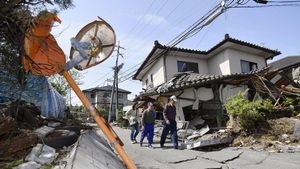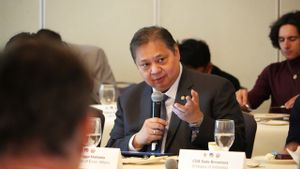JAKARTA - A powerful 7.6 magnitude earthquake that rocked Japan January 1, 2024 was caused by the movement of a fault or fault that stretches about 150 kilometers below the Noto Peninsula.
Another factor is seismic activity which is likely to continue for a while. This was conveyed by a number of experts as stated by the Kyodo news agency quoted via Antara, Wednesday, January 3.
Kyodo, as well as a number of Japanese mass media, did not disclose the name of the fault or fault that triggered the earthquake that Sunday.
Experts believe the 7.6 magnitude earthquake was caused by an inverted fault, when the top wall of the fault shifted upward away from the footwall (part of the fault under the fault sector).
The tectonic activity area is widespread in and around the Noto Peninsula so residents around this area are required to remain vigilant against possible aftershocks that could have a magnitude 7 on the Japanese earthquake intensity scale, the panel of experts said.
Strong seismic activity has been detected in the northern part of the Noto Peninsula located in Ishikawa Prefecture, since December 2020, experts say.
This area has been rocked by an earthquake measuring 5.4 magnitudes in June 2022 and an earthquake measuring M6.5 in May 2023.
An earthquake measuring M7.6 rocked the city of Shika in Ishikawa Prefecture on Monday afternoon, and the Noto Peninsula and its surroundings experienced aftershocks of up to 5 magnitudes.
"Until now, it is not known exactly which part of the fault is moving," said Naoshi Hirata from the University of Tokyo, who leads the panel of experts.
Meanwhile, the Japan Times reported that several nuclear power plants along the coast of the Sea of Japan were protected from serious damage from the devastating earthquake.
But the earthquake, which triggered tsunami warnings from Hokkaido to Kyushu and the issuance of evacuation orders in nine prefectures in Japan, could spark public concern about the safety of nuclear power in the earthquake-prone country.
Whereas at the same time Prime Minister Fumio Kishida plans to increase the use of PLTN as part of the Japanese government's "green transformation" policy.
In Ishikawa Prefecture, the Hokuriku Electric Power nuclear power plant in Shika experienced a partial electrical system disruption, but there were no major irregularities.
Reactor No. 1 and No. 2 at the PLTN were out of service before the earthquake on Sunday occurred, the Japan Times wrote.
SEE ALSO:
The English, Chinese, Japanese, Arabic, and French versions are automatically generated by the AI. So there may still be inaccuracies in translating, please always see Indonesian as our main language. (system supported by DigitalSiber.id)
Most Popular Tags
#Prabowo Subianto #golkar #Pilkada Dki #online gambling #Mount Lewotobi malePopular
24 November 2024, 03:15
24 November 2024, 05:29


















